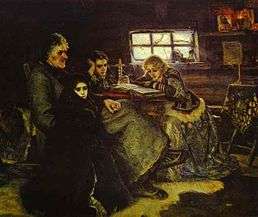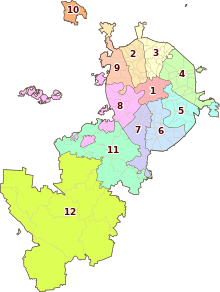Lyublino District
Coordinates: 55°40′30″N 37°46′00″E / 55.67500°N 37.76667°E
.png)
Lyublino (Russian: Люблино) is a district of South-Eastern Administrative Okrug of the federal city of Moscow, Russia. Population: 165,759 (2010 Census);[1] 152,100 (2002 Census).[2] The district's area is 17.41 square kilometers (6.72 sq mi), making it the ninth biggest district in Moscow.
History
In the mid-16th century, there was a village, known as Godunovo, on the shores of the Goled River. In the 1680s, for the first time, this area was mentioned as Godunovo-Lyublino. In 1772, it was mentioned simply as Lyublino.
During the 18th century, areas of Lyublino were owned by several Russian princes, the most notorious of them are Durasov family, who created Lyublino Park around their estate. In the 19th century Lyublino had been a simple town near Moscow, until a railroad was built there. After 1870 many workshops were built near the railroad station.
In 1866, Fyodor Mikhaylovich Dostoyevsky was living in Lyublino. His impressions about summer spent in Lyublino were described in his novella The Eternal Husband. Also, the great Russian painter Vasily Surikov drew his famous masterpiece "Menshikov v Beryozove" there.

In 1925, Lyublino officially became a town, having absorbed all of the surrounding towns. During the Soviet Era Lyublino became a part of Moscow in 1960, as a part of Zhdanovsky District. In 1969 Lyublinsky District was separated from Zhdanovsky District. By the 1970s almost all of the single-storey buildings were destroyed, being replaced with apartment buildings.
References
- ↑ Russian Federal State Statistics Service (2011). "Всероссийская перепись населения 2010 года. Том 1" [2010 All-Russian Population Census, vol. 1]. Всероссийская перепись населения 2010 года (2010 All-Russia Population Census) (in Russian). Federal State Statistics Service. Retrieved June 29, 2012.
- ↑ Russian Federal State Statistics Service (May 21, 2004). "Численность населения России, субъектов Российской Федерации в составе федеральных округов, районов, городских поселений, сельских населённых пунктов – районных центров и сельских населённых пунктов с населением 3 тысячи и более человек" [Population of Russia, Its Federal Districts, Federal Subjects, Districts, Urban Localities, Rural Localities—Administrative Centers, and Rural Localities with Population of Over 3,000] (XLS). Всероссийская перепись населения 2002 года [All-Russia Population Census of 2002] (in Russian). Retrieved August 9, 2014.
External links
- Официальный сайт управы района «Люблино» (Russian)
- Официальный сайт муниципального образования «Люблино» (Russian)
